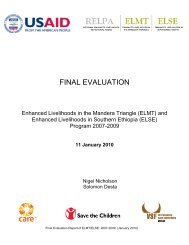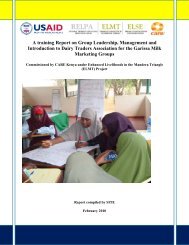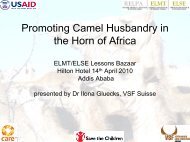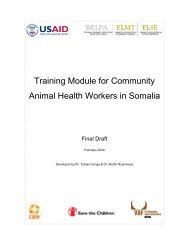A Report on the Camel Milk Marketing Clusters in ... - ELMT Home
A Report on the Camel Milk Marketing Clusters in ... - ELMT Home
A Report on the Camel Milk Marketing Clusters in ... - ELMT Home
Create successful ePaper yourself
Turn your PDF publications into a flip-book with our unique Google optimized e-Paper software.
CARE KENYA/SITE NOV 2009<br />
The pastoralist communities use wooden gourds for storage of camel milk. Their <strong>in</strong>ner surfaces<br />
are not very smooth <strong>the</strong>refore <strong>the</strong>y reta<strong>in</strong> milk residues after clean<strong>in</strong>g which shortens <strong>the</strong> keep<strong>in</strong>g<br />
quality of <strong>the</strong> milk stored <strong>in</strong> <strong>the</strong>m. They are however ideal for<br />
fermentati<strong>on</strong> and storage of fermented milk.<br />
Alum<strong>in</strong>ium milk c<strong>on</strong>ta<strong>in</strong>ers would be <strong>the</strong> best for <strong>the</strong> storage of<br />
camel milk s<strong>in</strong>ce <strong>the</strong>y are easy to clean and sterilize. It is also easy<br />
to cool milk stored <strong>in</strong> <strong>the</strong>m by dipp<strong>in</strong>g <strong>the</strong> cans <strong>in</strong> clean cold<br />
water.<br />
Wooden milk c<strong>on</strong>ta<strong>in</strong>ers Alum<strong>in</strong>ium or sta<strong>in</strong>less steel sufurias with lids can also be used for<br />
stor<strong>in</strong>g milk s<strong>in</strong>ce <strong>the</strong>y are easy to clean, sterilize and are locally<br />
available. P roper clean<strong>in</strong>g of <strong>the</strong> gourds will immediately improve <strong>the</strong> quality of milk before<br />
acquisiti<strong>on</strong> of <strong>the</strong> alum<strong>in</strong>ium c<strong>on</strong>ta<strong>in</strong>ers.<br />
iii. Equipment of milk transport<br />
<strong>Milk</strong> transport <strong>in</strong> Garissa is currently dom<strong>in</strong>ated by plastic c<strong>on</strong>ta<strong>in</strong>ers of various sizes rang<strong>in</strong>g<br />
from 5 liters to 20 litres. They are widely available from <strong>the</strong> local Garissa market and are mostly<br />
ex-cook<strong>in</strong>g oil plastic c<strong>on</strong>ta<strong>in</strong>ers. They are preferred by <strong>the</strong> transporters<br />
because <strong>the</strong>y are easily tied <strong>on</strong>to <strong>the</strong> milk transport vehicles. They typically<br />
have a hole <strong>on</strong> <strong>the</strong>ir lid and a str<strong>in</strong>g through it as a way of secur<strong>in</strong>g <strong>the</strong> lid.<br />
Alum<strong>in</strong>ium/sta<strong>in</strong>less steel milk transport cans would be <strong>the</strong> recommended<br />
transport c<strong>on</strong>ta<strong>in</strong>ers to replace <strong>the</strong> plastic <strong>on</strong>es if <strong>the</strong>re was no challenge <strong>in</strong><br />
transportati<strong>on</strong> and temperatures. This is because <strong>the</strong>y are easy to clean,<br />
sanitize, are durable and unlike <strong>the</strong> plastic milk c<strong>on</strong>ta<strong>in</strong>ers, <strong>the</strong>y are good<br />
A plastic milk c<strong>on</strong>ta<strong>in</strong>er heat c<strong>on</strong>ductors hence can allow for easy heat<strong>in</strong>g and cool<strong>in</strong>g of milk <strong>in</strong><br />
<strong>the</strong>m. However, due to <strong>the</strong> mode of milk transport be<strong>in</strong>g used currently, it<br />
would be necessary to have harnesses for <strong>the</strong> alum<strong>in</strong>ium milk cans - <strong>in</strong> form of baskets made out<br />
of natural or artificial gunny bag material. The harnesses will allow for <strong>the</strong> ty<strong>in</strong>g of <strong>the</strong> milk <strong>on</strong>to<br />
<strong>the</strong> transport vehicle and will also cushi<strong>on</strong> <strong>the</strong> milk cans aga<strong>in</strong>st knock-impact dur<strong>in</strong>g transit.<br />
Alum<strong>in</strong>ium milk cans and scoop<br />
The harnesses would shield <strong>the</strong> milk aga<strong>in</strong>st dust. In additi<strong>on</strong>, wett<strong>in</strong>g <strong>the</strong> milk harnesses just<br />
before milk transit will also allow for evaporative cool<strong>in</strong>g of <strong>the</strong> milk thus leng<strong>the</strong>n<strong>in</strong>g its shelf<br />
life. The camel milk handlers were <strong>in</strong>troduced to <strong>the</strong>se alum<strong>in</strong>ium cans dur<strong>in</strong>g <strong>the</strong> tra<strong>in</strong><strong>in</strong>g <strong>on</strong><br />
hygienic milk handl<strong>in</strong>g. The cans are available <strong>in</strong> many sizes rang<strong>in</strong>g from 5 litres, 10, 15 upto<br />
50 litres from several manufacturers’ <strong>in</strong> Nairobi’s Industrial area as well as imports from India.<br />
Assignment <str<strong>on</strong>g>Report</str<strong>on</strong>g> under <strong>ELMT</strong> compiled by SITE<br />
29












